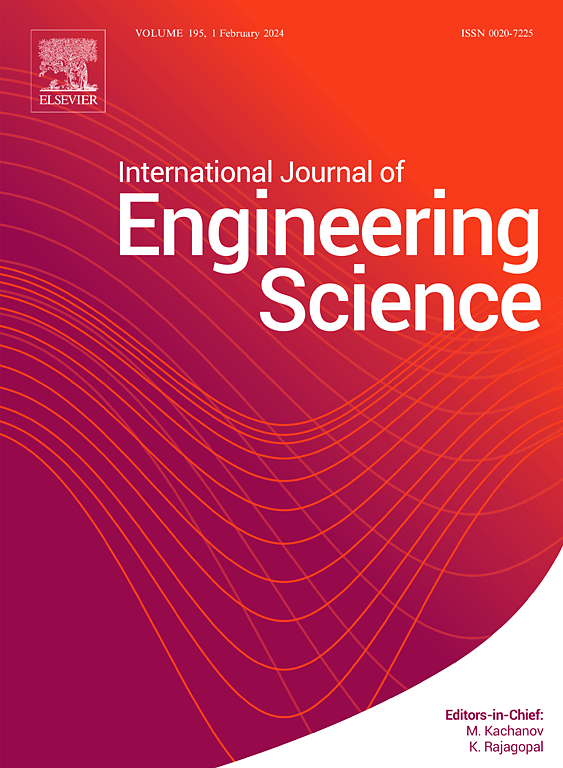Analytical study to control phase gradient in elastic meta-interface for wave mode conversions
IF 5.7
1区 工程技术
Q1 ENGINEERING, MULTIDISCIPLINARY
International Journal of Engineering Science
Pub Date : 2025-09-23
DOI:10.1016/j.ijengsci.2025.104388
引用次数: 0
Abstract
We present an analytical and design framework for achieving efficient elastic wave mode conversion across meta-interfaces governed by Generalized Snell’s Law (GSL), which prescribes wave motion based on a spatial phase gradient along the interface. In contrast to conventional optimization-based approaches, our method provides clear physical insight into the mechanism of pressure-to-shear wave conversion through a simplified one-dimensional axial wave model with the transfer matrix approach. This model yields analytical expressions for geometric conditions and identifies the relevant design parameter space. Based on this framework, we propose a compact chiral-pattern subunit with a frequency-scalable geometry, enabling straightforward implementation across a range of wave conditions. Full-scale numerical simulations confirm that the resulting meta-interface achieves strong mode conversion performance and accurately reproduces key phenomena including transmitted angles. Additionally, we demonstrate symmetric transmission by introducing mirrored phase gradients, further validating the flexibility of the GSL-based design. While the conversion efficiency is constrained by angular limits inherent to the material’s Poisson ratio, the framework provides a foundation for future improvements. This work bridges analytical modeling and practical design, offering an interpretable and scalable approach to engineered wave manipulation.
波型转换弹性元界面中相位梯度控制的解析研究
我们提出了一个分析和设计框架,用于实现由广义斯涅尔定律(GSL)控制的跨元界面的有效弹性波模式转换,该定律规定了基于沿界面的空间相位梯度的波运动。与传统的基于优化的方法相比,我们的方法通过简化一维轴波模型和传递矩阵方法,对压力-剪切波转换机制提供了清晰的物理洞察。该模型给出了几何条件的解析表达式,并确定了相应的设计参数空间。基于这个框架,我们提出了一个紧凑的手性模式子单元,具有频率可扩展的几何形状,可以在一系列波浪条件下直接实现。全尺寸数值模拟证实,所得到的元界面实现了较强的模式转换性能,并准确地再现了包括透射角在内的关键现象。此外,我们通过引入镜像相位梯度来演示对称传输,进一步验证了基于gsl设计的灵活性。虽然转换效率受到材料泊松比固有的角度限制的限制,但该框架为未来的改进提供了基础。这项工作连接了分析建模和实际设计,为工程波浪操纵提供了一种可解释和可扩展的方法。
本文章由计算机程序翻译,如有差异,请以英文原文为准。
求助全文
约1分钟内获得全文
求助全文
来源期刊

International Journal of Engineering Science
工程技术-工程:综合
CiteScore
11.80
自引率
16.70%
发文量
86
审稿时长
45 days
期刊介绍:
The International Journal of Engineering Science is not limited to a specific aspect of science and engineering but is instead devoted to a wide range of subfields in the engineering sciences. While it encourages a broad spectrum of contribution in the engineering sciences, its core interest lies in issues concerning material modeling and response. Articles of interdisciplinary nature are particularly welcome.
The primary goal of the new editors is to maintain high quality of publications. There will be a commitment to expediting the time taken for the publication of the papers. The articles that are sent for reviews will have names of the authors deleted with a view towards enhancing the objectivity and fairness of the review process.
Articles that are devoted to the purely mathematical aspects without a discussion of the physical implications of the results or the consideration of specific examples are discouraged. Articles concerning material science should not be limited merely to a description and recording of observations but should contain theoretical or quantitative discussion of the results.
 求助内容:
求助内容: 应助结果提醒方式:
应助结果提醒方式:


